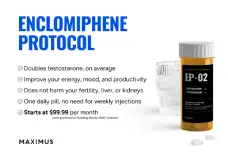You should upgrade or use an alternative browser.
What is the Function of Sex Hormone Binding Globulin SHBG?
- Thread starter bluerage
- Start date
Vince Carter
Banned
CoastWatcher
Moderator
Gene Devine
Super Moderator
SHBG also plays a key role in regulating bioavailable sex-steroid concentrations through competition of sex steroids for available binding sites and fluctuations in SHBG concentrations. Because of the higher affinity of SHBG for DHT and T, compared to E, SHBG also has profound effects on the balance between bioavailable androgens and estrogens.
Increased SHBG levels may be associated with symptoms and signs of hypogonadism in men, while decreased levels can result in androgenization in women.
Vince Carter
Banned
Low SHBG is not a problem at all, smaller, more frequent injections, if not daily injections, are how it's dealt with. When I was on E3.5D, I was up and down and up and down and up and down, its not a fun ride, as it were. But injecting more often gets the Total T up and keeps it there.
Vince Carter
Banned
Thanks Vince. Any idea how smaller more frequent injections effect DHT, free, and bio available T? I'd like to keep these in check.
Free and Bio avail T are pretty much the same thing and a high Free T, over lab ranges or 3% or higher is key marker for low SHBG. Obvious correlation if there's less SHBG to bind your T, the higher your Free T will be. You can see some guys post labs with no SHBG test but see their Free T is very high and with near certainty predict they have low SHBG. I've read little to nothing that Free T over range is anything but good. DHT though with EOD (or daily) I have to specifically use a cream daily on the sctorum to raise my DHT so I can't say if I have a DHT problem with 5AR activity, DHT problem related to SHBG, or what the root cause is or was there.
CoastWatcher
Moderator
You definitely want to educate yourself on shbg because it really influences how much and how often you should inject.
SHBG values are critically important, particularly as a protocol is being implemented/refined.
CoastWatcher
Moderator
I'm a new member and have no idea how to get in touch with a moderator...I would like to talk to someone that is very knowledgeable about hpta restart. Nelson Vergel or yourself, can you please contact me
Check for a personal message. In the future, pm one of us or start a new thread. Please don't hijack an active thread.
Nelson Vergel
Founder, ExcelMale.com
Abstract
Aims: Testosterone and its binding protein sex hormone-binding globulin have been associated with cardiovascular disease and dysglycaemia. However, information on the prognostic implication in patients at high cardiovascular risk with dysglycaemia is inconsistent. The study objective was to determine whether testosterone and/or sex hormone-binding globulin predict cardiovascular events or death in dysglycaemic patients.
Methods: Dysglycaemic males (with high blood sugar) at high cardiovascular risk (n = 5553) who participated in the Outcome Reduction with an Initial Glargine Intervention (ORIGIN) trial and provided baseline blood samples were studied. Testosterone and sex hormone-binding globulin were measured at baseline and used to estimate free testosterone. Low levels of total and free testosterone were defined as ≤300 ng/dl and ≤7 ng/dl, respectively. Patients were followed for six years for cardiovascular events (defined as the composite of cardiovascular death, non-fatal myocardial infarction or stroke) and all-cause mortality.
Results: The mean total and free testosterone levels were 416.6 ng/dl and 8.4 ng/dl, and low levels were present in 13% and 37% of the patients. The median sex hormone-binding globulin level was 35 nmol/l. In Cox regression models adjusted for age, previous diseases and pharmacological treatment, neither total nor free testosterone predicted cardiovascular events. However, a one-standard-deviation increase in sex hormone-binding globulin predicted both cardiovascular events (hazard ratio 1.07; 95% confidence interval 1.00–1.14; p = 0.03) and all-cause mortality (hazard ratio 1.13; 95% confidence interval 1.06–1.21; p < 0.01).
Conclusion: Sex hormone-binding globulin, but not total testosterone, predicts cardiovascular disease and all-cause mortality in dysglycaemic males at high cardiovascular risk.
Keywords Testosterone, sex hormone-binding globulin, cardiovascular, prognosis, diabetes, glucose intolerance
Source
Nelson Vergel
Founder, ExcelMale.com
Androgens and estrogens are transported bound to the sex hormone binding globulin (SHBG). SHBG is believed to keep sex steroids inactive and to control the amount of free hormones that enter cells by passive diffusion. Contrary to the free hormone hypothesis, we demonstrate that megalin, an endocytic receptor in reproductive tissues, acts as a pathway for cellular uptake of biologically active androgens and estrogens bound to SHBG. In line with this function, lack of receptor expression in megalin knockout mice results in impaired descent of the testes into the scrotum in males and blockade of vagina opening in females. Both processes are critically dependent on sex-steroid signaling, and similar defects are seen in animals treated with androgen- or estrogen-receptor antagonists. Thus, our findings uncover the existence of endocytic pathways for protein bound androgens and estrogens and their crucial role in development of the reproductive organs.
Nelson Vergel
Founder, ExcelMale.com

Serum SHBG Is Associated With the Development and Regression of Nonalcoholic Fatty Liver Disease: A Prospective Study
Nelson Vergel
Founder, ExcelMale.com
Nelson Vergel
Founder, ExcelMale.com

A Reappraisal of Testosterone's Binding in Circulation: Physiological and Clinical Implications - PubMed
Nelson Vergel
Founder, ExcelMale.com
Circulating SHBG level as a biomarker of metabolic risk
In epidemiologic studies, low total testosterone levels have been associated with increased risks of diabetes and metabolic syndrome, a cluster of conditions including hypertension, insulin resistance, central obesity, and dyslipidemia, which predispose individuals to an increased risk of cardiovascular disease. In longitudinal analyses, SHBG levels rather than total or free testosterone levels have been independently and prospectively associated with incident diabetes and metabolic syndrome after adjustments for age, adiposity, and comorbid conditions (97, 98). Among children and adolescents, SHBG may also be a biomarker for metabolic syndrome risk (99), and lower levels were more robustly associated with the risk of metabolic syndrome in boys than in girls (100). We do not know whether SHBG is merely a marker of metabolic risk or whether SHBG plays a causal role in the pathophysiology of metabolic disorders such as diabetes and metabolic syndrome.
Source: Reappraisal of Testosterone’s Binding in Circulation: Physiological and Clinical Implications
Nelson Vergel
Founder, ExcelMale.com
SHBG and exogenous administered drugs, xenobiotics and alcohol
Numerous drugs influence SHBG serum levels via variation of its hepatic synthesis rate. SHBG synthesis is e as already mentioned above e modulated by sex steroids. Application of estrogenic, progestogenic and androgenic compounds will therefore result in altered SHBG concentrations.
Estrogens cause considerable increases in SHBG levels. The extent is dependent on the route of administration: oral formulations will cause more pronounced effects than transdermal ones as the active component directly accesses the portal system and the liver will be exposed to very high concentrations [10,12,68]. With application of tamoxifen, raloxifene and clomiphene SHBG levels have been observed in both sexes. Hence, selective estrogen receptor modulators generally seem to exhibit agonistic characteristics with respect to SHBG synthesis [12,69]. As well, SHBG elevations in adrenal carcinoma patients treated with mitotane are attributed to the drug's agonistic effects on hepatic estrogen receptors [70]. Progestins on the other hand have been known for a long time to significantly decrease SHBG serum levels [71]. Consequently, SHBG levels in women receiving combination oral contraceptives (COC) depend on the proportion of the contained estrogen and progestin [72]. Application of androgens in male hypogonadism as well as suppression of pituitary gonadotropin release with the testosterone derivative danazol causes
SHBG concentrations to decrease [12,73,74]. A drop of SHBG levels has also been described with the use of the antiandrogen cyproterone acetate. The observation is attributed to its progestogenic properties but might also be due to partly agonistic effects in the liver [12]. Beyond sex steroids,treatment with synthetic glucocorticoids has been associated with decreasing SHBG levels. Findings,however, are inconsistent across different studies and results of in vitro experiments are ambiguous [13].
Another class of drugs influencing SHBG levels are hepatic enzyme inducers like phenobarbital, phenytoin, carbamazepine or rifampicin, which regularly result in elevated SHBG concentrations [10].
The effect has been best investigated in liver enzyme inducing antiepileptic drugs (LEIAED). Increased SHBG concentrations in men on LEIAED therapy contribute to the common hormonal and reproductive disturbances in these patients [75]. In women, LEIAED associated SHBG increase might cause failure of COC by tightly binding progestins and lowering free progestin levels.
Finally, SHBG and drugs are not only interconnected via hepatic synthesis but also by plasma steroid transport. Drugs might exert their effects and side effects by occupying SHBG binding sites and displacing the natural ligands. Furthermore, SHBG has been implied in the transport of xenobiotic ligands in plasma and across cell membranes [13]. Both topics, however, require further research to enable proper judgment of relevance.
Moderate alcohol consumption is associated with slightly but significantly decreased SHBG levels in both sexes in the majority of studies [76,77]. In e non-cirrhotic e alcoholics, however, approximately 3-fold increased SHBG-levels have been described, which might contribute to the hypogonadism often observed in these patients [78]. Beyond that, chronic alcohol ingestion also impairs glycosylation during protein synthesis resulting in SHBG isoforms with altered carbohydrate composition. Withdrawal causes SHBG levels to decrease promptly, but values within reference ranges are only reached after several weeks of abstinence [78].
Awareness of the relation of drugs and SHBG levels helps to explain some effects and side effects of therapy. When not explicitly evaluating gonadal and sexual dysfunction, however, there is no need to determine SHBG in day-to-day routine in patients receiving the respective medication. The connections of SHBG and xenobiotics require more detailed investigations and might constitute a rewarding research area.
Reference: The biomarker sex hormone-binding globulin – From established applications to emerging trends in clinical medicine
Nelson Vergel
Founder, ExcelMale.com
How to decrease SHBG and increase free testosterone - Excel Male Health Forum
hCG Mixing Calculator
HCG Mixing Protocol Calculator
Similar threads
- Sticky
- Replies
- 30
- Views
- 5K
- Replies
- 1
- Views
- 5K
- Replies
- 5
- Views
- 2K
TRT Hormone Predictor
Predict estradiol, DHT, and free testosterone levels based on total testosterone
⚠️ Medical Disclaimer
This tool provides predictions based on statistical models and should NOT replace professional medical advice. Always consult with your healthcare provider before making any changes to your TRT protocol.
ℹ️ Input Parameters
Predicted Hormone Levels
Enter your total testosterone value to see predictions
Results will appear here after calculation
Understanding Your Hormones
Estradiol (E2)
A form of estrogen produced from testosterone. Important for bone health, mood, and libido. Too high can cause side effects; too low can affect well-being.
DHT
Dihydrotestosterone is a potent androgen derived from testosterone. Affects hair growth, prostate health, and masculinization effects.
Free Testosterone
The biologically active form of testosterone not bound to proteins. Directly available for cellular uptake and biological effects.
Scientific Reference
Lakshman KM, Kaplan B, Travison TG, Basaria S, Knapp PE, Singh AB, LaValley MP, Mazer NA, Bhasin S. The effects of injected testosterone dose and age on the conversion of testosterone to estradiol and dihydrotestosterone in young and older men. J Clin Endocrinol Metab. 2010 Aug;95(8):3955-64.
DOI: 10.1210/jc.2010-0102 | PMID: 20534765 | PMCID: PMC2913038
Beyond Testosterone Podcast
Online statistics
- Members online
- 0
- Guests online
- 297
- Total visitors
- 297
Latest posts
-
-
-
-
Using MOD-GRF 1-29 / CJC-1295 (no DAC) by itself:
- Latest: Vincent Nunez
-
-
-
Impact of pornography on men's and women's sexuality and sexual health
- Latest: BadassBlues
-












